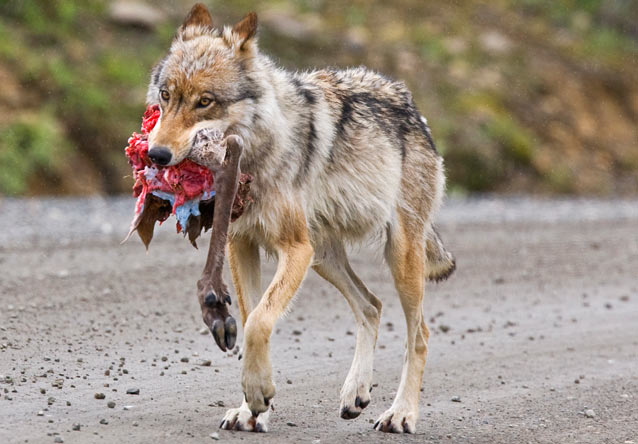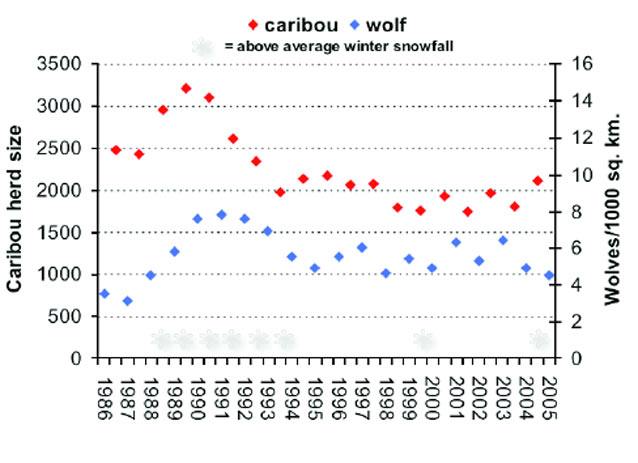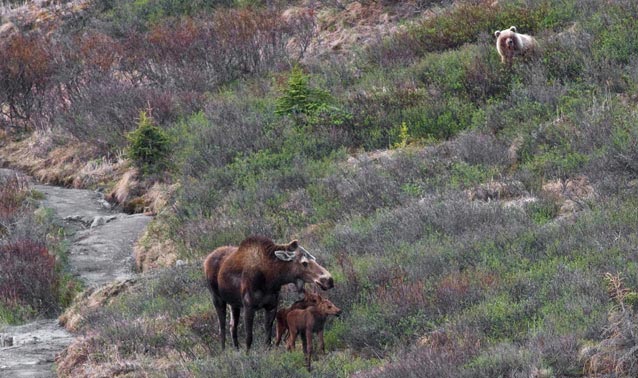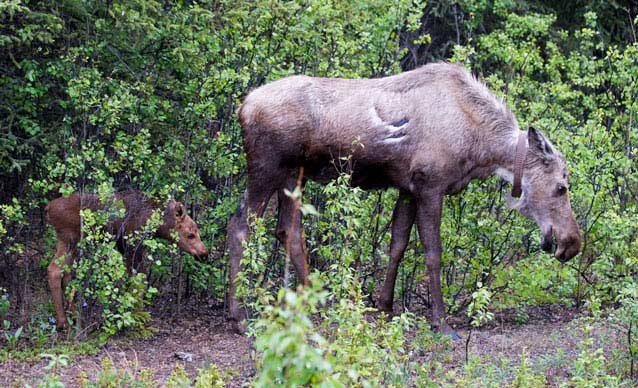Denali’s large mammals interact in an age-old drama in their roles as predators and prey. While each species has a substantially different role, each individual has the same goals of survival and reproduction.

NPS Photo / Ken Conger
Along with its sweeping mountain landscapes, Denali National Park and Preserve (Denali) is probably best known for opportunities to observe the large mammals common to Interior Alaska.
Locally known as the “Big Five,” gray wolves (Canis lupus), grizzly bears (Ursus arctos), moose (Alces alces), caribou (Rangifer tarandus) and Dall sheep (Ovis dalli) have coexisted in the region for millennia. While many other animals occur in Denali, none are as readily associated with the park environment as these species.
In addition to the opportunities for viewing or photographing Interior Alaska’s large mammals, Denali is a great natural laboratory to study the species and their interrelationships. Unlike the rest of Interior Alaska, the Denali carnivore/ungulate community has been little affected by human harvests for several decades, and interactions of these species are driven largely by natural phenomena.
It is a common perception that large mammals are “abundant” within the protected confines of the park boundaries, but that is not the case. Throughout much of Interior Alaska, large mammals occur at low densities naturally, and Denali is no exception. Although Denali encompasses over 6,600 square miles (17,100 km2) of suitable habitat, population estimates in the mid-2000s suggested about 100 wolves, 350 grizzly bears, 2,000 caribou, 1,900 moose, and 1,800 Dall sheep occur there. In comparison, areas of the Tanana Flats and northern Alaska Range adjacent to Denali on the east have long been managed for human harvests, and moose occur there at about six times the density of Denali.

NPS Photo / Lian Law
Denali’s large mammals interact in an age-old drama in their roles as predators and prey. While each species has a substantially different role, each individual has the same goals of survival and reproduction. Predators must find and kill sufficient prey, while ungulates employ strategies to minimize their risks of becoming a meal. For both predators and prey to persist, the capabilities of predators must be roughly counteracted by the vigor and predation-avoidance behaviors of the ungulates. However, the stage for this drama is constantly changing, providing challenges or advantages to the participants, and affecting the numbers that survive at any given time.
Winter snowfall is probably the most obvious factor that influences predator/prey relationships and population trends (Mech et al. 1998). Since 1924, total winter snowfall measured at park headquarters has averaged 80 inches (203 cm), but has varied from 31 to 174 inches (79-442 cm), indicating an extreme range of winter conditions experienced by wildlife in Denali.
We know most about the effects of winter snowfall on wolf and caribou populations in Denali because of intensive studies of each species begun in 1986 (Adams 1996, Mech et al. 1998). Those studies began near the end of more than a decade of winters with snowfalls that were well below average and continued through six consecutive winters of deep snows of 90 to 155 inches (229-394 cm), providing a powerful opportunity to gain insights into effects of winter conditions on these two species.
In 1986, the Denali Caribou Herd numbered about 2,600 animals and was increasing 7% per year. At the time, the wolf population in Denali included about 60 animals, a number lower than expected based on the abundance of ungulates. Wolf pup production was poor, and dispersal of young wolves was high. With severe winters from 1988 to 1994, wolf numbers rapidly increased, reaching 130 wolves by late winter 1990 and staying high through the 1992-93 winter. The caribou herd reached 3,200 individuals by autumn 1989 but declined to about 2,000 by autumn 1993. Recruitment of calves was poor, averaging only 12 calves per 100 cows in fall 1990-93, compared to 35 per 100 during 1984-89. Further, winter mortality rates of adult cows tripled from about 5% to 15% annually. Winter snowfalls have returned to more average levels since 1994. Wolf numbers declined to an average of 92 wolves during 1994-2005, and the caribou population leveled off at about 2,000 animals, with improvement in adult survival but continued poor recruitment of calves.

Winter is Coming
These trends in population size for wolves and caribou resulted from several cascading effects linked to changes in winter conditions. With low snowfall, caribou have large expanses of wind-blown, snow-free terrain to seek forage, and they can maintain adequate nutritional condition to make it through the winter in good shape. Additionally, with little snow most can easily evade wolves by running from them. At the same time, wolves can find it difficult to acquire adequate prey when few ungulates are vulnerable, and they must focus on killing individuals that are injured, old, otherwise debilitated, or unlucky (Mech et al. 1995). With few vulnerable prey, wolf packs tend to be small in number because of lower pup production or survival and increased dispersal of young wolves.
As winter snowfalls increase, the balance tips in favor of wolves. Caribou have more difficulty finding enough to eat because they must either forage on wind-blown alpine ridges where little forage occurs or expend energy digging through deep or crusted snow. Deep snow can also impede their ability to evade wolves. Although caribou prefer to feed on wind-blown areas like mountain ridges, such places are commonly surrounded by deep snow, and it is relatively easy for wolves to chase caribou into the deep snow where they are highly vulnerable, regardless of their physical condition. In particularly severe winters, multiple kills of caribou are not uncommon in these situations, and selection for debilitated individuals is less obvious (Mech et al. 1995). With food easier to acquire, wolves can flourish. New packs form, and existing packs get bigger because more pups survive and fewer young wolves disperse from their natal packs (Meier et al.1995).Together these changes can result in big increases in wolf numbers over a short time period; Denali wolves increased by 30% a year during 1988-1990 as a result of severe winter conditions (Mech et al. 1998).
In addition to the direct effects described above, we have also found indirect effects of winter severity on caribou calf production and survival resulting from the nutritional restriction they experience in harsh winters. If winters are severe enough, poor nutritional condition can carry through the summer to the fall breeding season, affecting pregnancy rates (Adams and Dale 1998a) and the timing of calving the next year (Adams and Dale 1998b). Female calves that experience severe winters are unlikely to breed until they are 2 or 3 years old, whereas about half of those that have it easy their first winter breed as yearlings (Adams and Dale 1998a). Calves that are born following a severe winter are lighter at birth (Adams 2005), grow more slowly (Adams 2003), and experience higher mortality in the weeks following birth (Adams et al. 1995a, 1995b).
Moose and Dall sheep are also affected by the magnitude of winter snows, but each is influenced differently depending on its body size, food habits, and habitat selection. It takes more snow to affect the nutritional status of moose because of their taller stature and because their winter forage of twigs and branches largely occurs above the snowpack. However, moose calves begin to feel the effects of severe winters at lower snowdepths than do adults. Dall sheep winter on wind-blown mountain slopes that provide forage and escape cover among the rocky crags. These areas tend to be snow-free in all but the most severe winters, but wet snow or rain in midwinter can encase the forage on which sheep rely in a covering of ice. With their relatively short legs and reliance on rocky terrain for security from predation, Dall sheep have limited ability to move through deep snow to areas with better foraging conditions when icing occurs, and such movements make them highly vulnerable to wolf predation.

NPS Photo / Kent Miller
Because moose, caribou, and Dall sheep are affected differently by winter conditions, their relative vulnerability to predation by wolves changes from year to year. Also, each ungulate population is made up of a variety of ages, and each sex/age class has its own vulnerabilities. In general, the year’s young, older individuals, and mature males, worn out from the fall breeding season, are more vulnerable to predation than prime-aged adult females. Further, these ungulates are not equally distributed across the landscape, so each wolf pack has a different assemblage of prey to pursue. Moose are more numerous in the foothills along the Alaska Range in winter and relatively rare in the forested flatlands of the park.
Sheep are found in some of the mountainous areas of the park; they do not occur in the Kantishna Hills and are rare in the foothills immediately north of Mt. McKinley. Caribou aggregate in only a few areas in winter, and important wintering areas can change as winter progresses as well as from year to year. Therefore, caribou and sheep may be abundant in some wolf pack territories and absent from others. All of these factors complicate the relationships between wolf predation and the population dynamics of both wolves and their ungulate prey.
Grizzly bears add another degree of complexity. While ungulates and wolves can be neatly categorized as primary consumers (herbivores) and secondary consumers (carnivores) in Denali’s food web, grizzlies fit in both categories. As omnivores, they rely on plant material for part of their diet and therefore are affected by growing season conditions, similar to the ungulates. In particular, berry production in late summer can greatly affect nutritional status of bears as they enter dens for the winter.
Bears also are significant predators of young ungulates, particularly caribou and moose, in the weeks following birth. Unlike wolves, grizzly bears have low reproductive rates, low survival of young, little dispersal, and can live for over 30 years. With these life history traits and their limited reliance on ungulates in their diet, population trends of grizzly bears are very loosely tied, if at all, to the status of ungulate populations. As a result, their influences on ungulate population dynamics may be diminished when those populations are high and increase as populations decline.

NPS Photo / Kent Miller
Although we have focused on how population trends and interactions of Denali’s large mammals are affected by winter severity, other climatic factors are undoubtedly important in the dynamics of this system, but their effects can be more difficult to discern. In general, variability in weather may be the greatest driver for fluctuations in the large mammal predator/prey community. Our understanding of this particular system has largely accumulated as warming trends in global climate have become more recognizable in northern latitudes. It is too early to tell how climate change will influence the large mammal species in Denali. Given the complexities involved in the day-to-day interactions of these species, we expect that many of the effects will be difficult to predict, or down-right surprising.
References
Adams, L.G. 1996.
Calf production and survival in the Denali Caribou Herd, Alaska. Ph.D. Thesis. University of Minnesota, St. Paul.
Adams, L.G. 2003.
Marrow fat deposition and skeletal growth in caribou calves. Journal of Wildlife Management 67(1):20-24.
Adams, L.G. 2005.
Effects of maternal characteristics and climatic variation on birth masses of Alaskan caribou. Journal of Mammalogy 86(3):506-513.
Adams, L.G., and B.W. Dale. 1998a.
Reproductive performance of female Alaskan caribou. Journal of Wildlife Management 62:1184-1195.
Adams, L.G., and B.W. Dale. 1998b.
Timing and synchrony of parturition in barrenground caribou. Journal of Mammalogy 79:287-294.
Adams, L.G., B.W. Dale, and L.D. Mech. 1995a.
Wolf predation on caribou calves in Denali National Park, Alaska. In Ecology and conservation of wolves in a changing world: proceedings of the second North American symposium on wolves, edited by L.N. Carbyn, S.H. Fritts, and D.R. Seip. Canadian Circumpolar Institute Occasional Paper 35. University of Alberta, Edmonton. Pages 245-260.
Adams, L.G., F.J. Singer, and B.W. Dale. 1995b.
Caribou calf mortality in Denali National Park, Alaska. Journal of Wildlife Management 59:584-594.
Mech, L.D., L.G. Adams, T.J. Meier,
J.W. Burch, and B.W. Dale. 1998. The wolves of Denali. University of Minnesota Press.
Mech, L.D., T.J. Meier, J.W. Burch, and L.G. Adams. 1995.
Patterns of prey selection by wolves in Denali National Park, Alaska. In Ecology and conservation of wolves in a changing world: proceedings of the second North American symposium on wolves, edited by L.N. Carbyn, S.H. Fritts, and D.R. Seip. Canadian Circumpolar Institute Occasional Paper 35. University of Alberta, Edmonton. Pages 231-244.
Meier, T.J., J.W. Burch, L.D. Mech, and L.G. Adams. 1995.
Pack structure and genetic relatedness among wolf packs in a naturally regulated population. In Ecology and conservation of wolves in a changing world: proceedings of the second North American symposium on wolves, edited by L.N. Carbyn, S.H. Fritts, and D.R. Seip. Canadian Circumpolar Institute Occasional Paper 35. University of Alberta, Edmonton. Pages 293-302.
Part of a series of articles titled Alaska Park Science - Volume 5 Issue 1: Scientific Studies in Denali.
Previous: Tracking the Movement of Denali's Wolves
Last updated: March 16, 2015
